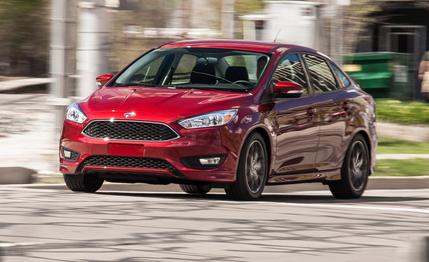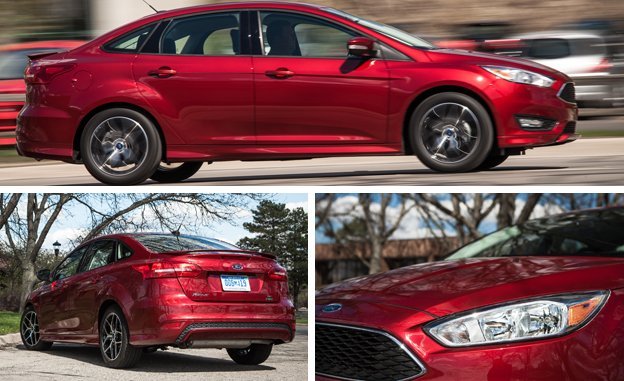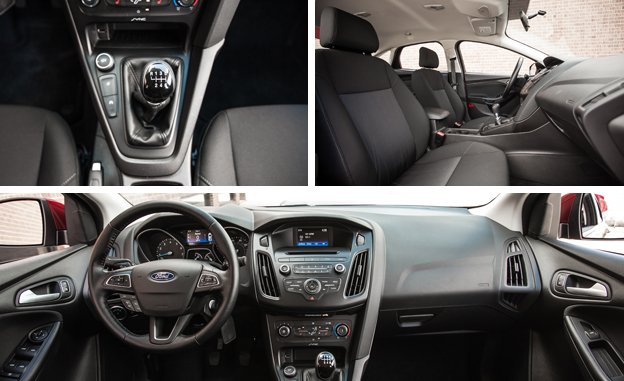
 Instrumented Test
Instrumented Test
We spend an awful lot of our energy analyzing and quantifying speed. Entire stories are centered around straight-line acceleration, the effects of different tires on 707-hp muscle cars at the drag strip (okay, one 707-hp muscle car), and even prodding rental cars to their top speeds—in reverse. We interrupt that programming to present a test of something decidedly not all that fast: the three-cylinder 2015 Ford Focus EcoBoost sedan.


First introduced in the smaller Fiesta last year, Ford’s 1.0-liter three-cylinder EcoBoost engine joins the refreshed-for-2015 Focus lineup as a $795 option. Available only on the midlevel, SE-spec Focus, the EcoBoost displaces 999 cc (61 cubic inches!) yet, thanks to turbocharging and direct injection, squeezes out 123 horsepower and 148 lb-ft of torque. A six-speed manual is the only transmission choice (regular Focuses get a five-speed or an optional six-speed dual-clutch automatic), and an engine stop-start fuel-saving feature is standard.
As you’d expect from a vehicle with one fewer cylinder than is typical for its size and price—compact sedans typically are powered by four-cylinder engines, four-cylinder engines, or four-cylinder engines—the Focus EcoBoost is pokier to 60 mph than every manual-transmission Focus we’ve tested by roughly two seconds. With half the displacement of the base Focus’s 2.0-liter four (and 37 fewer horsepower and 2 more lb-ft of torque), even the extra gear can’t help much, as our recorded performance figures show. The run to 60 mph requires 9.4 seconds, and you could do your taxes in the time it takes to cover the quarter-mile.
Even so, we really enjoy the 1.0-liter engine. It’s a fantastic little mill, quiet in operation and capable of mean-sounding growls when caned. But while the EcoBoost is a surprisingly juicy performer in the Fiesta, it’s squeezed dry moving the larger Focus. That’s what the Focus’s 2972-pound curb weight does to a powerplant that represents the “downsized” option even in the nearly 350-pounds-lighter Fiesta. Remove haste from your priorities, and the EcoBoost Focus slides into a happier mode. Outside of the paucity of torque off idle, one could almost be fooled into thinking they’re driving a regular, naturally aspirated, four-cylinder Focus.
The EPA rates this EcoBoost at 29 mpg in the city and 40 on the highway (2 mpg better than the most efficient four-cylinder Focus in the city, and the same on the highway). We managed 33 mpg, dead-on the EPA’s combined estimate and 3 mpg better than we saw in the 1.0-liter Fiesta sedan. The stop-start system proved fairly smooth in killing and re-firing the engine at stoplights, too. When the likes of BMW and Land Rover have trouble restarting four-cylinder engines smoothly with similar systems, the Focus’s relatively jolt-free starts are a triumph. There’s no escaping the three-cylinder’s distinct throat clearing upon reawakening, however. If you don’t like it, the system can be turned off completely.


As we’ve seen with other 2015 Focuses, our test car was noticeably quieter than earlier models (we noted 70 decibels at a 70-mph cruise, compared with 71 in the last Focus sedan we tested), thanks to laminated front windows and extra sound-deadening material. Perhaps even better, the updated non-touch-screen audio controls are laid out more logically than before. Using the radio is now an intuitive affair, a good thing, as Ford made the steering-wheel controls for infotainment functions a bit smaller.
The midlevel Focus SE—again, the only trim level available with the EcoBoost three—comes well-equipped for $20,080 (the hatchback body style adds $500). Besides the 1.0-liter engine for $795, our test car featured a neat SE EcoBoost package that added $700 and a set of slick 17-inch aluminum wheels, a body kit, fog lamps, and rear disc brakes. Chuck in another $645 for the Cold Weather package (heat for the front seats, the leather-wrapped steering wheel, and the side mirrors), $255 for parking sensors, and $395 for our test car’s stunning Ruby Red paint, and the total comes to an entirely reasonable $22,075.
But the most important number here is really the EcoBoost’s $795 upcharge. As a livable daily driver, the 1.0-liter Focus is a good car. It’s up to you whether sacrificing some speed for a few extra miles per gallon is worth it.